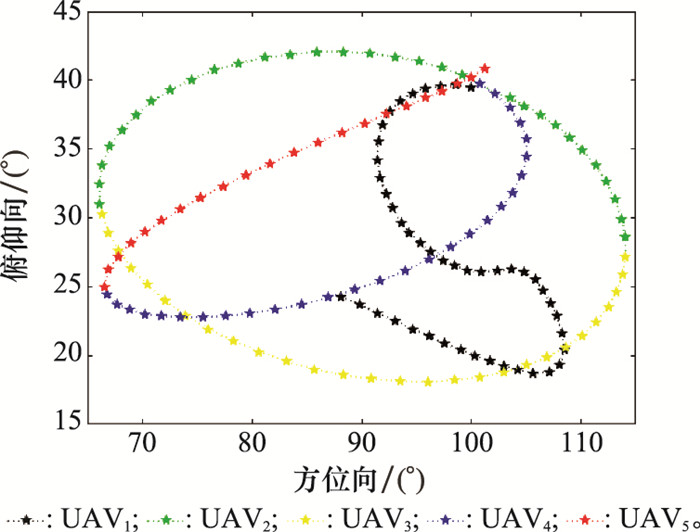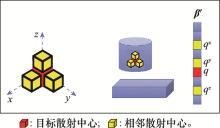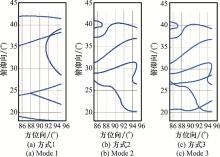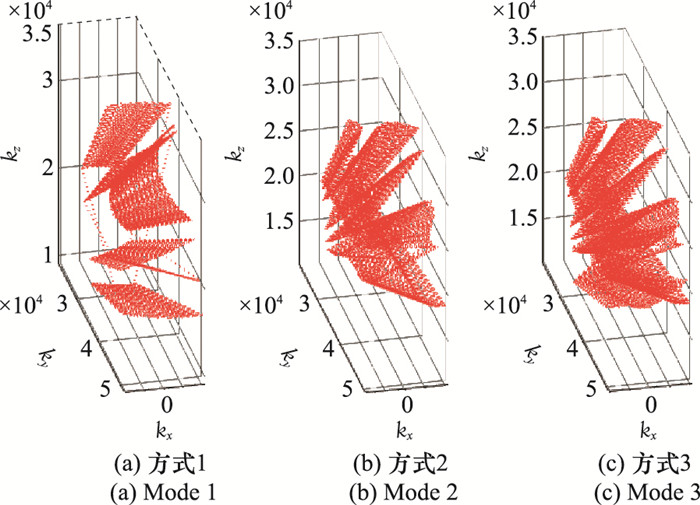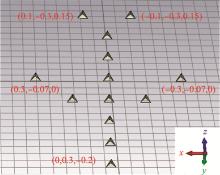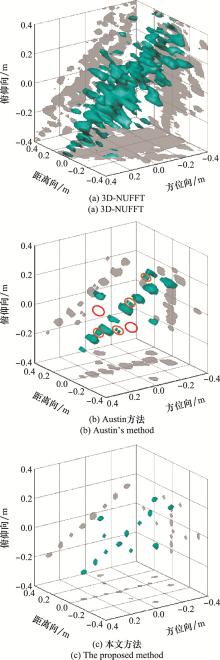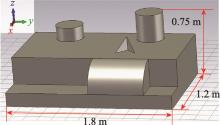Systems Engineering and Electronics ›› 2021, Vol. 43 ›› Issue (4): 901-910.doi: 10.12305/j.issn.1001-506X.2021.04.06
• Sensors and Signal Processing • Previous Articles Next Articles
3D sparse imaging for non-uniformly sampled SAR based on feature enhancement
Dou SUN1( ), Shiqi XING1,*(
), Shiqi XING1,*( ), Haifeng GAO2(
), Haifeng GAO2( ), Bo PANG1(
), Bo PANG1( ), Yongzhen LI1(
), Yongzhen LI1( ), Xuesong WANG1(
), Xuesong WANG1( )
)
- 1. State Key Laboratory of Complex Electromagnetic Environment Effects on Electronics and Information System, College of Electronic Science, National University of Defense Technology, Changsha 410073, China
2. Shaanxi Provincial Geological Survey Institute, Xi'an 710054, China
-
Received:2020-07-10Online:2021-03-25Published:2021-03-31 -
Contact:Shiqi XING E-mail:sundou14@nudt.edu.cn;xingshiqi_paper@163.com;117968769@qq.com;pangbo84826@126.com;e0061@sina.com;wxs1019@vip.sina.com
CLC Number:
Cite this article
Dou SUN, Shiqi XING, Haifeng GAO, Bo PANG, Yongzhen LI, Xuesong WANG. 3D sparse imaging for non-uniformly sampled SAR based on feature enhancement[J]. Systems Engineering and Electronics, 2021, 43(4): 901-910.
share this article
| 1 |
DUNGAN K E P L C . 3-D Imaging of vehicles using wide aperture radar[J]. IEEE Trans. on Aerospace and Electronic Systems, 2011, 47 (1): 187- 200.
doi: 10.1109/TAES.2011.5705669 |
| 2 | LI C P, ZHOU X M, CHANG L. Application of feature modelling method based on SAR image in target interpretation[C]//Proc. of the IET International Radar Conference, 2019: 6210-6213. |
| 3 |
JOERG H , PARDINI M , HAJNSEK I , et al. 3-D scattering characterization of agricultural crops at C-band using SAR tomography[J]. IEEE Trans. on Geoence and Remote Sensing, 2018, 56 (7): 3976- 3989.
doi: 10.1109/TGRS.2018.2818440 |
| 4 | ERTIN E , MOSES R L , POTTER L C . Interferometric methods for three-dimensional target reconstruction with multipass circular SAR[J]. IET Radar, Sonar & Navigation, 2010, 4 (3): 464- 473. |
| 5 |
FENG D , AN D X , HUANG X T , et al. A phase calibration method based on phase gradient autofocus for airborne holographic SAR imaging[J]. IEEE Geoence and Remote Sensing Letters, 2019, 16 (12): 1864- 1868.
doi: 10.1109/LGRS.2019.2911932 |
| 6 |
PONCE O , PRATS-IRAOLA P , SCHEIBER R , et al. First airborne demonstration of holographic SAR tomography with fully polarimetric multicircular acquisitions at L-band[J]. IEEE Trans. on Geoence and Remote Sensing, 2016, 54 (10): 6170- 6196.
doi: 10.1109/TGRS.2016.2582959 |
| 7 |
AUSTIN C D , ERTIN E , MOSES R L . Sparse signal methods for 3-D radar imaging[J]. IEEE Journal of Selected Topics in Signal Processing, 2011, 5 (3): 408- 423.
doi: 10.1109/JSTSP.2010.2090128 |
| 8 | LIU D, BOUFOUNOS P T. Compressive sensing based 3D SAR imaging with multi-PRF baselines[C]//Proc. of the IEEE International Geoscience and Remote Sensing Symposium, 2014. |
| 9 |
FREY O , MAGNARD C , RUEGG M , et al. Focusing of airborne synthetic aperture radar data from highly nonlinear flight tracks[J]. IEEE Trans. on Geoence and Remote Sensing, 2009, 47 (6): 1844- 1858.
doi: 10.1109/TGRS.2008.2007591 |
| 10 |
AXELSSON S R J . Beam characteristics of three-dimensional SAR in curved or random paths[J]. IEEE Trans. on Geoence and Remote Sensing, 2004, 42 (10): 2324- 2334.
doi: 10.1109/TGRS.2004.834802 |
| 11 |
ZHANG S , ZHU Y , DONG G , et al. Truncated SVD-based compressive sensing for downward-looking three-dimensional SAR imaging with uniform/nonuniform linear array[J]. IEEE Geoence and Remote Sensing Letters, 2015, 12 (9): 1853- 1857.
doi: 10.1109/LGRS.2015.2431254 |
| 12 |
AGUASCA A , ACEVO-HERRERA R , BROQUETAS A , et al. ARBRES: light-weight CW/FM SAR sensors for small UAVs[J]. Sensors, 2013, 13 (3): 3204- 3216.
doi: 10.3390/s130303204 |
| 13 | LORT M , AGUASCA A , LOPEZ-MARTINEZ C , et al. Initial evaluation of SAR capabilities in UAV multicopter platforms[J]. IEEE Journal of Selected Topics in Applied Earth Observations and Remote Sensing, 2018, PP (99): 1- 14. |
| 14 | LI J C , CHEN J , WANG P B , et al. Sensor-oriented path planning for multiregion surveillance with a single lightweight UAV SAR[J]. Sensors, 2018, |
| 15 |
FREY O , MEIER E . 3-D time-domain SAR imaging of a forest using airborne multibaseline data at L-and P-bands[J]. IEEE Trans. on Geoence and Remote Sensing, 2011, 49 (10): 3660- 3664.
doi: 10.1109/TGRS.2011.2128875 |
| 16 |
PENG X , HONG W , WANG Y , et al. Polar format imaging algorithm with wave-front curvature phase error compensation for airborne DLSLA three-dimensional SAR[J]. IEEE Geoence and Remote Sensing Letters, 2014, 11 (6): 1036- 1040.
doi: 10.1109/LGRS.2013.2282335 |
| 17 |
XING S Q , LI Y Z , DAI D H , et al. Three-dimensional reconstruction of man-made objects using polarimetric tomographic SAR[J]. IEEE Trans. on Geoence and Remote Sensing, 2013, 51 (6): 3694- 3705.
doi: 10.1109/TGRS.2012.2220145 |
| 18 |
TIAN H , LI D . Sparse flight array SAR downward-looking 3-D imaging based on compressed sensing[J]. IEEE Geoence and Remote Sensing Letters, 2016, 13 (10): 1395- 1399.
doi: 10.1109/LGRS.2016.2560238 |
| 19 |
SUN D , XING S Q , LI Y Z , et al. Sub-aperture partitioning me-thod for three-dimensional wide-angle synthetic aperture radar imaging with non-uniform sampling[J]. Electronics, 2019, 8 (6): 629- 643.
doi: 10.3390/electronics8060629 |
| 20 |
NGUYEN N H , BERRY P , TRAN H T . Compressive sensing for tomographic imaging of a target with a narrowband bistatic radar[J]. Sensors, 2019, 19 (24): 5515- 5532.
doi: 10.3390/s19245515 |
| 21 | WANG P , LIU M , WANG Z . Three-dimensional SAR imaging of sea targets with low PRF sampling[J]. IET Radar, Sonar & Navigation, 2018, 12 (3): 294- 300. |
| 22 |
HU X W , TONG N N , GUO Y D , et al. MIMO radar 3D imaging based on multi-dimensional sparse recovery and signal support prior information[J]. IEEE Sensors Journal, 2018, 18 (8): 3152- 3162.
doi: 10.1109/JSEN.2018.2810705 |
| 23 |
SUNZ M , PANG B , XING H H , et al. Direct 3-D sparse imaging using non-uniform samples without data interpolation[J]. Electronics, 2020, 9 (2): 321- 335.
doi: 10.3390/electronics9020321 |
| 24 |
SUN C , WANG B P , FANG Y , et al. Multichannel and wide-angle SAR imaging based on compressed sensing[J]. Sensors, 2017, 17 (2): 295- 315.
doi: 10.3390/s17020295 |
| 25 | SAMADI S , CETIN M , MASNADI-SHIRAZI M A . Sparse representation-based synthetic aperture radar imaging[J]. IET Radar, Sonar & Navigation, 2011, 5 (2): 182- 193. |
| 26 |
LI Z , JIN K , XU B , et al. An improved attributed scattering model optimized by incremental sparse Bayesian learning[J]. IEEE Trans. on Geoence and Remote Sensing, 2016, 54 (5): 2973- 2987.
doi: 10.1109/TGRS.2015.2509539 |
| 27 |
JACKSON J A , RIGLING B D , MOSES R L . Canonical scattering feature models for 3D and bistatic SAR[J]. IEEE Trans. on Aerospace and Electronic Systems, 2010, 46 (2): 525- 541.
doi: 10.1109/TAES.2010.5461639 |
| 28 |
ZENG J , LIN S , WANG Y , et al. L1/2 Regularization: convergence of iterative half thresholding algorithm[J]. IEEE Trans. on Signal Processing, 2014, 62, 2317- 2329.
doi: 10.1109/TSP.2014.2309076 |
| 29 |
CETIN M , KARL W C . Feature-enhanced synthetic aperture radar image formation based on nonquadratic regularization[J]. IEEE Trans. on Image Processing, 2001, 10 (4): 623- 631.
doi: 10.1109/83.913596 |
| 30 | MOORE L , POTTER L , ASH J . Three-dimensional position accuracy in circular synthetic aperture radar[J]. IEEE Trans. on Aerospace and Electronic Systems, 2014, 29, 29- 40. |
| [1] | Tian MIAO, Hongcheng ZENG, He WANG, Jie CHEN. A fast extraction method of flood areas based on iterative threshold segmentation using spaceborne SAR data [J]. Systems Engineering and Electronics, 2022, 44(9): 2760-2768. |
| [2] | Caiyun WANG, Yida WU, Jianing WANG, Lu MA, Huanyue ZHAO. SAR image target recognition based on combinatorial optimization convolutional neural network [J]. Systems Engineering and Electronics, 2022, 44(8): 2483-2487. |
| [3] | Dongning FU, Guisheng LIAO, Yan HUANG, Bangjie ZHANG, Xing WANG. Time-varying narrow-band interference suppression algorithm for SAR based on graph Laplacian embedding [J]. Systems Engineering and Electronics, 2022, 44(6): 1846-1853. |
| [4] | Minghui GAI, Su ZHANG, Weitian SUN, Yude NI, Lei YANG. Structural-feature enhancement of SAR targets based on complex value compatible total variation [J]. Systems Engineering and Electronics, 2022, 44(6): 1862-1872. |
| [5] | Anlin XU, Yu ZHANG, Feng ZHOU. High resolution ISAR imaging based on Beta process [J]. Systems Engineering and Electronics, 2022, 44(6): 1873-1879. |
| [6] | Penghui JI, Dahai DAI, Shiqi XING, Dejun FENG. Dense false moving targets generation method [J]. Systems Engineering and Electronics, 2022, 44(5): 1502-1511. |
| [7] | Fengkai LIU, Darong HUANG, Xinrong GUO, Cunqian FENG. Parametric translational compensation method for maneuvering target based on Lv's distribution [J]. Systems Engineering and Electronics, 2022, 44(4): 1166-1173. |
| [8] | Dong CHEN, Yanwei JU. Ship object detection SAR images based on semantic segmentation [J]. Systems Engineering and Electronics, 2022, 44(4): 1195-1201. |
| [9] | Xiaoling ZHOU, Zhaoxia ZHANG, Ya LU, Qian WANG, Kunkun WANG. SAR image recognition based on improved R-FCN [J]. Systems Engineering and Electronics, 2022, 44(4): 1202-1209. |
| [10] | Wenjing LI, Zhuolin LI, Zhentao YUAN. Sea clutter suppression and target extraction algorithm based on sparse reconstruction [J]. Systems Engineering and Electronics, 2022, 44(3): 777-785. |
| [11] | Lei YANG, Su ZHANG, Minghui GAI, Cheng FANG. High-resolution SAR imagery with enhancement of directional structure feature [J]. Systems Engineering and Electronics, 2022, 44(3): 808-818. |
| [12] | Siyu DU, Yinghui QUAN, Minghui SHA, Wen FANG, Mengdao XING. Waveform optimization for SFA radar based on evolutionary particle swarm optimization [J]. Systems Engineering and Electronics, 2022, 44(3): 834-840. |
| [13] | Junjie WANG, Dejun FENG, Weidong HU. Two-dimensional SAR image modulation method based on time-varying materials [J]. Systems Engineering and Electronics, 2022, 44(2): 455-462. |
| [14] | Cheng FANG, Huijuan LI, Wen LU, Yumeng SONG, Lei YANG. Multi-feature enhancement algorithm for high resolution SAR based on morphological auto-blocking [J]. Systems Engineering and Electronics, 2022, 44(2): 470-479. |
| [15] | Yu LEI, Xiangguang LENG, Xiaoyan ZHOU, Zhongzhen SUN, Kefeng JI. Recognition method of ship target in complex SAR image based on improved ResNet network [J]. Systems Engineering and Electronics, 2022, 44(12): 3652-3660. |
| Viewed | ||||||
|
Full text |
|
|||||
|
Abstract |
|
|||||

